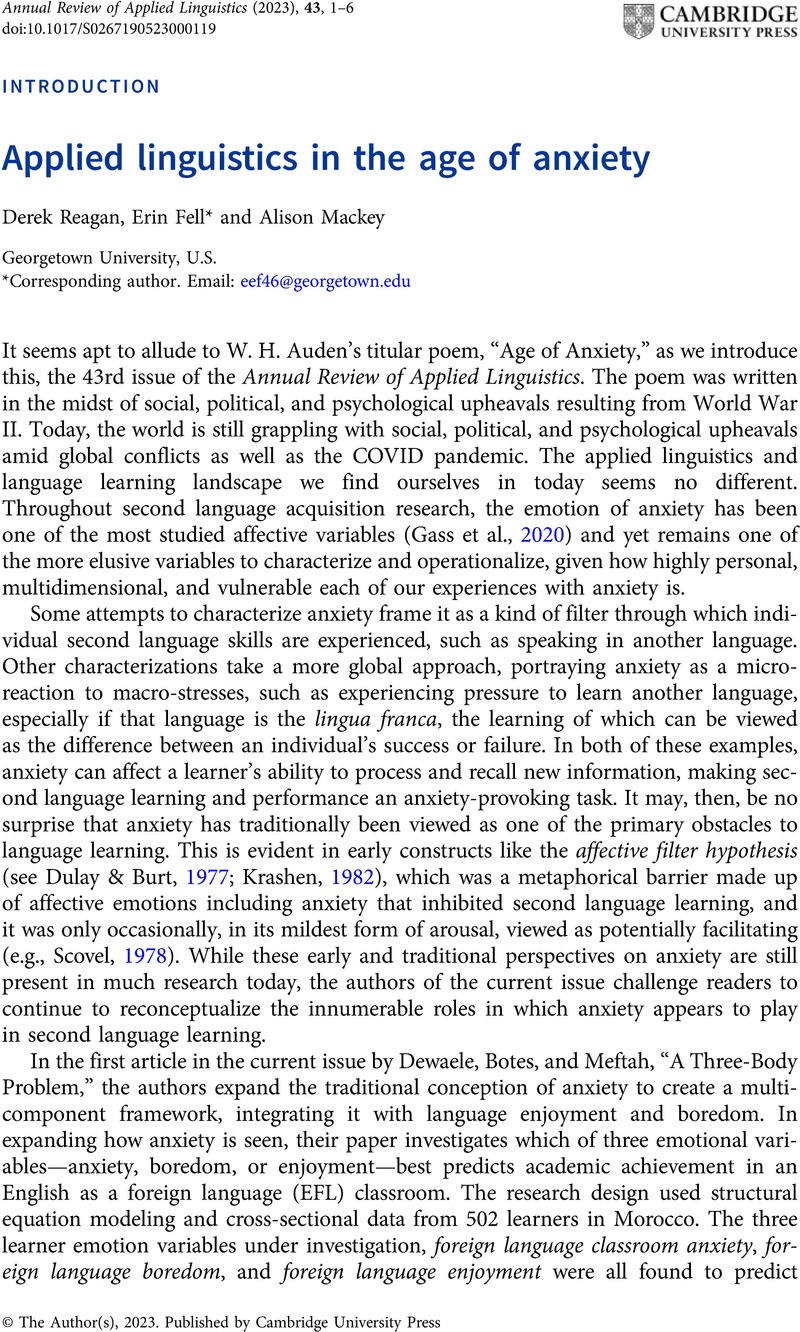No CrossRef data available.
Article contents
Applied linguistics in the age of anxiety
Published online by Cambridge University Press: 14 August 2023
Abstract
An abstract is not available for this content so a preview has been provided. Please use the Get access link above for information on how to access this content.

- Type
- Introduction
- Information
- Copyright
- Copyright © Cambridge University Press 2023
References
Botes, E., Dewaele, J. M., & Greiff, S. (2020). The foreign language classroom anxiety scale and academic achievement: An overview of the prevailing literature and a meta-analysis. Journal for the Psychology of Language Learning, 2(1), 26–56.CrossRefGoogle Scholar
Dulay, H., & Burt, M. (1977). Remarks on creativity in language acquisition. In Burt, M., Dulay, H., & Finocchiaro, M. (Eds.), Viewpoints on English as a second language (pp. 95–126). Regents.Google Scholar
Gass, S. M., Behney, J., & Plonsky, L. (2020). Second language acquisition: An introductory course. Routledge.CrossRefGoogle Scholar
Hong, J., Hwang, M., Liu, Y., & Tai, K. (2020). Effects of gamifying questions on English grammar learning mediated by epistemic curiosity and language anxiety. Computer Assisted Language Learning, 35(7), 1458–1482. https://doi.org/10.1080/09588221.2020.1803361CrossRefGoogle Scholar
Horwitz, E. (2001). Language anxiety and achievement. Annual Review of Applied Linguistics, 21, 112–126. http://doi:10.1017/S0267190501000071.CrossRefGoogle Scholar
Horwitz, E. K., Horwitz, M. B., & Cope, J. (1986). Foreign language classroom anxiety. Modern Language Journal, 70, 125–132. https://doi.org/10.1111/j.1540-4781.1986.tb05256.x.CrossRefGoogle Scholar
Krashen, S. (1982). Principles and practice in second language acquisition. Pergamon Press.Google Scholar
Larsen-Freeman, D., & Cameron, L. (2008). Complex systems and applied linguistics. Oxford University Press.Google Scholar
Mahmoodzadeh, M., & Khajavy, G. H. (2019). Towards conceptualizing language learning curiosity in SLA: An empirical study. Journal of Psycholinguistic Research, 48(2), 333–351. https://doi.org/10.1007/s10936-018-9606-3.CrossRefGoogle ScholarPubMed
Scovel, T. (1978). The effect of affect: A review of the anxiety literature. Language Learning, 28, 129–142.CrossRefGoogle Scholar
Seligman, M. E. P., & Csikszentmihalyi, M. (2000). Positive psychology: An introduction. American Psychologist, 55, 5–14.CrossRefGoogle ScholarPubMed
Teimouri, Y., Goetze, J., & Plonsky, L. (2019). Second language anxiety and achievement: A meta-analysis. Studies in Second Language Acquisition, 41(2), 363–387.CrossRefGoogle Scholar
Verspoor, M., de Bot, K., & Lowie, W. (Eds.) (2011). A dynamic approach to second language development: Methods and techniques. John Benjamins.CrossRefGoogle Scholar
Zhang, X. (2019). Foreign language anxiety and foreign language performance: A meta-analysis. The Modern Language Journal, 103(4), 763–781.CrossRefGoogle Scholar



